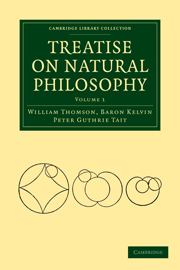Chapter IV - Measures and Instruments
Published online by Cambridge University Press: 07 September 2010
Summary
399. HAVING seen in the preceding chapter that for the investigation of the laws of nature we must carefully watch experiments, either those gigantic ones which the universe furnishes, or others devised and executed by man for special objects—and having seen that in all such observations accurate measurements of Time, Space, Force, etc., are absolutely necessary, we may now appropriately describe a few of the more useful of the instruments employed for these purposes, and the various standards or units which are employed in them.
400. Before going into detail we may give a rapid résumé of the principal Standards and Instruments to be described in this chapter. As most, if not all, of them depend on physical principles to be detailed in the course of this work—we shall assume in anticipation the establishment of such principles, giving references to the future division or chapter in which the experimental demonstrations are more particularly explained. This course will entail a slight, but unavoidable, confusion—slight, because Clocks, Balances, Screws, etc., are familiar even to those who know nothing of Natural Philosophy; unavoidable, because it is in the very nature of our subject that no one part can grow alone, each requiring for its full development the utmost resources of all the others. But if one of our departments thus borrows from others, it is satisfactory to find that it more than repays by the power which its impTovement affords them.
401.We may divide our more important and fundamental instruments into four classes—
Those for measuring Time;
„ „ Space, linear or angular;
„ „ Force;
„ „ Mass.
Other instruments, adapted for special purposes such as the measurement of Temperature, Light, Electric Currents, etc., will come more naturally under the head of the particular physical energies to whose measurement they are applicable. Descriptions of self-recording instruments such as tide-gauges, and barometers, thermometers, electrometers, recording photographically or otherwise the continuously varying pressure, temperature, moisture, electric potential of the atmosphere, and magnetometers recording photographically the continuously varying direction and magnitude of the terrestrial magnetic force, must likewise be kept for their proper places in our work.
- Type
- Chapter
- Information
- Treatise on Natural Philosophy , pp. 457 - 478Publisher: Cambridge University PressPrint publication year: 2009First published in: 1883

